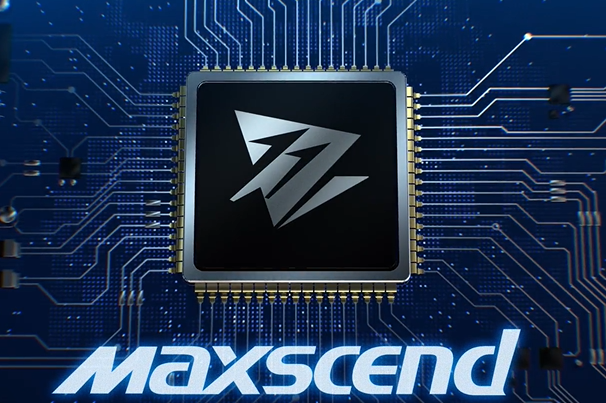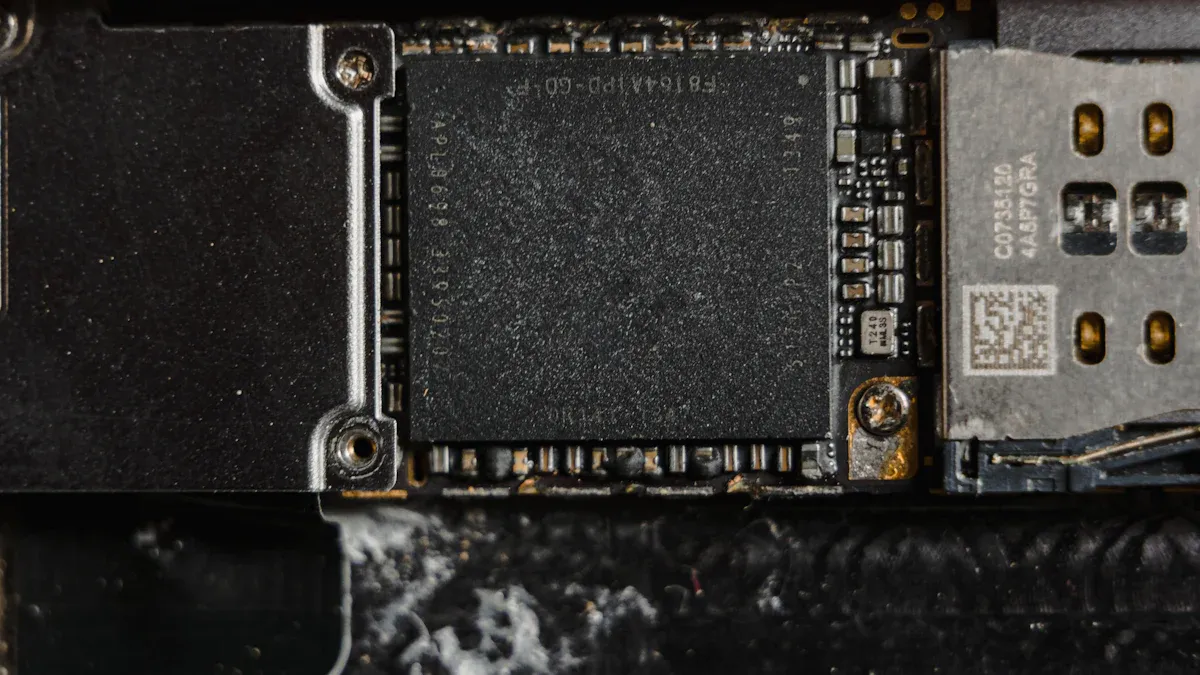The applications and uses of RF front-end chips like maxscend MASWSS0128 and MXD8650

RF front-end chips are essential components of modern wireless systems. These chips manage radio signals, enabling devices and networks to connect seamlessly. In 2023, the RF front-end chip market was valued at $18.5 billion and is projected to reach $30.2 billion by 2032, growing at an annual rate of 6.0%. Popular chips like MASWSS0128 and MXD8650 are widely utilized in applications such as smartphones, IoT, 5G, and satellite communication. They enhance signal strength and data transmission speeds, ensuring faster and more reliable connections. Keepbooming, a leading China maxscend chip distributor, plays a crucial role in supplying these cutting-edge RF front-end chips to markets worldwide.
Key Takeaways
RF front-end chips, like MASWSS0128 and MXD8650, help improve wireless communication in devices like phones and smart gadgets.
Picking the right RF chip depends on your needs; MASWSS0128 works best for low-power devices, while MXD8650 is great for high-frequency uses like 5G.
These chips make signals stronger and speed up data transfer, giving users faster and more stable connections.
The RF chip market is growing quickly, showing their importance in future tech like smart cities and self-driving cars.
Using special materials like gallium nitride (GaN) in RF chips saves energy and keeps signals strong.
Understanding RF Front-End Chips
What are RF front-end chips?
RF front-end chips are key parts of wireless systems. They handle radio signals, helping devices send and receive data easily. These chips have amplifiers, filters, and switches to control signal strength. By improving signals, they allow smooth connections between devices and networks.
A report called "RF Front-End Module Comparison 2020 – Volume 1" explains their features. These chips reduce signal loss and save power to work better. They are built into modern devices to support 5G and Wi-Fi 6. This makes them very important in today’s technology.
How do they help wireless systems?
RF front-end chips improve signal quality and make data transfer faster. For example, Wi-Fi 6E uses these chips for wider bandwidth and better performance. Phones like the Samsung Galaxy S23 Ultra use Wi-Fi 6E chips for fast and smooth internet.
Research on SOI (Silicon on Insulator) shows its benefits for these chips. It improves power use, reduces signal problems, and stops interference. These features make RF chips great for 5G, IoT, and satellites.
IoT devices also need RF chips to work well. These chips boost and clean signals for smart devices and wearables. As wireless tech grows, RF chips become even more important.
Applications of MASWSS0128

Use in mobile devices
MASWSS0128 helps mobile devices work better. It improves signal strength and makes communication faster and more reliable. This chip supports health apps on phones, which help users stay active. For example, studies show health apps can make patients with long-term illnesses exercise more. These apps also give personal tips, which keep users motivated. The table below shows these findings:
Findings | What it Means |
|---|---|
Health apps help sick patients exercise more. | Shows MASWSS0128 helps health apps work well. |
Benefits can last for months. | Apps may help users for a long time. |
Personal tips boost motivation. | Custom advice makes apps more helpful. |
MASWSS0128 keeps devices connected, helping health apps work smoothly. This improves user experience and results.
Role in IoT systems
MASWSS0128 is important for smart devices in IoT systems. It helps devices talk to each other by improving signals and reducing problems. For example, it helps smart thermostats get correct data from sensors. Fitness trackers also use it to send health data to apps in real-time. Its ability to handle many signals at once makes it perfect for IoT devices like smart homes and wearables.
Applications in wireless communication
Wireless systems use MASWSS0128 to work better. It makes data transfer faster and reduces signal loss. Wi-Fi routers use it for quicker internet and stable connections. It is also key in 5G networks, managing complex signals for fast communication. Its smart design helps modern wireless systems, making it essential for future technology.
Applications of MXD8650

Importance in 5G technology
The MXD8650 chip is vital for improving 5G networks. It boosts signal handling, making data transfer quicker and smoother. This chip works well with high-frequency bands needed for 5G. It ensures strong and steady communication for connected devices. It can manage many signals at once, which is great for crowded cities. By making networks more reliable, MXD8650 improves video streaming, gaming, and virtual reality experiences.
Use in satellite communication
The MXD8650 chip is important for satellite systems. Its small size and advanced features fit space missions perfectly. Technologies like RFSoC and MxFE make satellites smaller and lighter. This lowers launch costs and saves time during development. The table below shows why MXD8650 is useful for satellites:
Advantage/Feature | Description |
|---|---|
Size and Weight | RFSoC and MxFE make satellites smaller and lighter for space. |
Cost Efficiency | These technologies cut mission costs, including launches and development. |
Integration and Testing | Easier integration shortens development and testing times. |
Application Versatility | Works for geolocation, MIMO, radar, and other uses. |
Compatibility with Small Satellites | Perfect for CubeSats and small satellites, boosting launch chances. |
The MXD8650 chip also supports geolocation and radar systems. This makes it a flexible and powerful choice for satellite communication.
Applications in advanced technologies
The MXD8650 chip helps create new advanced technologies. It supports smart cities, self-driving cars, and factory automation. For example, it handles high-frequency signals for smart city devices to connect. In factories, it helps machines work better by sharing data instantly. Its flexibility and power make it essential for modern industries.
Comparing MASWSS0128 and MXD8650
Main differences in design and use
MASWSS0128 and MXD8650 are built for different tasks. MASWSS0128 works best in mobile devices and IoT gadgets. It boosts signals and cuts interference in low-power setups. Its small size makes it perfect for phones and fitness trackers.
MXD8650 is made for high-frequency uses like 5G and satellites. It handles tricky signals and many connections at once. Its advanced design allows fast data transfer. This makes it great for virtual reality and self-driving cars.
Shared uses and performance
Both MASWSS0128 and MXD8650 improve wireless communication. They make signals clearer and reduce data loss. MASWSS0128 powers smart home gadgets, while MXD8650 helps in industrial IoT. Both chips are key for reliable connections.
Each chip performs well in its area. MASWSS0128 keeps low-power devices connected. MXD8650 works best in high-frequency networks. Both handle multiple signals, showing their value in wireless tech.
Picking the right chip for your needs
Choosing the right chip depends on what you need. Tools like Decision Matrix and BRIDGeS can help decide.
Framework | Benefits | Drawbacks |
|---|---|---|
Decision Matrix | Fair and math-based choices. | Hard to use with many factors. |
Helps compare and rank options. | Ignores personal opinions. | |
BRIDGeS | Handles complex situations well. | Needs special tools and resources. |
Focuses on important details. | May require extra setup. |
These tools help pick the best chip by:
Defining the problem and needed features.
Ranking features using methods like MoSCoW.
Listing and comparing possible solutions.
Breaking down the chosen solution into steps.
For low-power gadgets, MASWSS0128 is better. For high-frequency tasks, MXD8650 is ideal. Knowing your needs helps pick the right RF chip.
Broader Impact of RF Front-End Chips
How they improve wireless technology
RF front-end chips have made wireless communication much better. They help send data faster, improve signals, and save energy. People now care more about saving energy to protect the environment. Because of this, companies use materials like gallium nitride (GaN) to make chips work better.
The RF chip market might grow to $65 billion by 2033. This shows how important these chips are becoming. New RF designs are needed for 5G and future networks. For example, Wi-Fi 7 chips show how they improve wireless devices. Augmented reality (AR) and virtual reality (VR) also need better 5G. These technologies need fast speeds and no delays, which RF chips provide.
Why they matter in telecom and IoT
Telecom and IoT industries depend on RF front-end chips. In telecom, these chips help 5G networks handle more data and faster speeds. In IoT, they connect smart devices easily. For example, fitness trackers use them to send health data to apps quickly.
In Asia-Pacific, 5G is growing fast, boosting RF chip production. Companies and telecom providers work together to make better chips. These partnerships create smaller, energy-saving chips for IoT and smart cities.
Their role in future technologies
RF chips will be key in new technologies. System-on-Chip (SoC) designs combine parts like amplifiers and filters. This makes chips smaller, cheaper, and better. The growth of 5G has increased the need for chips that handle many signals at once.
RF chips will help in self-driving cars and smart factories. They let cars talk to traffic systems using high-frequency signals. In factories, they help machines share data instantly, improving work. As tech grows, RF chips will shape the future of wireless communication.
RF front-end chips, like MASWSS0128 and MXD8650, improve wireless communication. They are used in phones, IoT, 5G, and satellites. These chips make antennas work better for strong and clear signals. New materials, like gallium nitride (GaN), help them handle more power. Smaller designs fit easily into modern devices. As more people use smart homes and aerospace tech, these chips become even more important. They keep pushing wireless technology forward and making it better.
1. What do RF front-end chips do?
RF front-end chips handle radio signals in wireless devices. They boost, clean, and control signals for smooth communication. These chips are used in smartphones, IoT gadgets, 5G systems, and satellites. They help transfer data faster and keep connections stable.
2. How are MASWSS0128 and MXD8650 different?
MASWSS0128 works best in low-power devices like phones and IoT tools. MXD8650 is better for high-frequency tasks like 5G and satellites. Each chip is made for specific jobs to perform well in its area.
3. Why do 5G networks need RF chips?
RF chips manage high-frequency signals needed for 5G. They make data faster, reduce delays, and handle many connections. This is important for things like virtual reality, smart cities, and self-driving cars.
4. Can RF chips save energy?
Yes, new RF chips use special materials like gallium nitride (GaN). These materials lower power use but keep signals strong. This makes them great for eco-friendly tech.
5. Which industries use RF front-end chips the most?
Telecom and IoT industries depend on RF chips. They connect 5G networks, smart homes, and factory systems. Aerospace and car industries also use them for advanced communication.
Tip: Knowing your project’s needs helps you pick the best RF chip.
See Also
AD9736BBCZ: Pioneering Innovations in Wireless Technology
Understanding MC9S12DJ256MFUE Specs for Vehicle Use
Enhancing Automotive Efficiency with NXP Microcontrollers
CALL US DIRECTLY
(+86)755-82724686
RM2508,BlockA,JiaheHuaqiangBuilding,ShenNanMiddleRd,Futian District,Shenzhen,518031,CN
www.keepboomingtech.com sales@keepboomingtech.com
